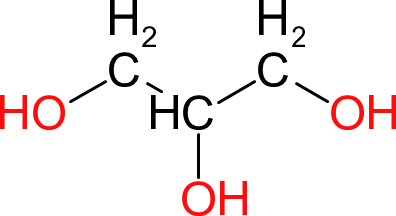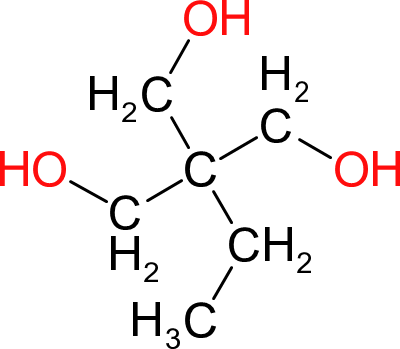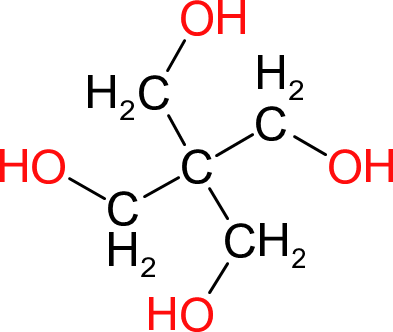| Name | Short Form | Structure | Molecular Mass (g.mole⁻¹) | Carbon Atoms | Base Functionality | Density (20°C) | Flash Point (°C) | Melting Point (°C) | Boiling Point (°C) |
| ALIPHATIC GLYCOLS |
|---|
| n-Butanol | |  | 74 | 4 | 1 | 0.81 | 35 | -90 | 118 |
| Rarely used in the resins under discussion except as a solvent. It is, however, extensively used in amino resins (e.g. urea/melamine formaldehyde resins). |
| |
| 1,4 Butane Diol | |  | 90 | 4 | 2 | 1.02 | 121 | 16 | 235 |
| Mostly used in saturated polyester resins where its flexibility, hydrolytic stability and durability are of advantage. |
| |
| MonoEthylene Glycol | MEG |  | 62 | 2 | 2 | 1.11 | 111 | -13 | 197 |
| The cheapest of the glycols, MEG tends to reduce the solubility of resins in solvents and is used sparingly with other glycols, like MPG. MEG is sometimes used with Pentaerythritol, in a 1:1 molar ratio, as a substitute for glycerine in alkyds when economically viable. Due to the low boiling point of MEG, losses during processing (± 5%) due to its volatility need to be compensated for in the initial formulation. |
| |
| Diethylene Glycol | DEG |  | 106 | 4 | 4 | 1.12 | 138 | -10 | 244 |
| DEG is low cost and adds flexibility to resins but reduces the resin's hydrolytic stability. DEG is mainly used in general purpose unsaturated polyesters. Due to the relatively low boiling point of DEG, losses during processing (± 2.5%) should be compensated for in the initial formulation. |
| |
| Propylene Glycol | MPG |  | 76 | 3 | 3 | 1.04 | 101 | -59 | 188 |
| One of the most common ingredients in unsaturated polyesters. MPG adds both rigidity and hydrolytic stability to the resin polymer backbone. Due to the low boiling point of MPG, losses during processing due to its volatility (± 12%) need to be compensated for in the initial formulation. |
| |
| Dipropylene Glycol | DPG |  | 134 | 6 | 2 | 1.02 | 121 | -32 | 231 |
| Mainly used in both saturated and unsaturated polyesters where flexibility is required whilst providing superior hydrolytic stability to that of DEG |
| |
| Glycerine | |  | 92 | 3 | 3 | 1.26 | 160 | 18 | 290 |
| Glycerine is always present in alkyds produced using natural oils but is also additionally added to improve solubility and flexibility. |
| |
| Trimethylol Propane | TMP |  | 134 | 6 | 3 | 1.08 | 172 | 58 | 289 |
| TMP, like glycerine, has a hydroxy functionality of 3. It is sometimes used in alkyds but is more predominantly found in saturated polyesters as it provides more rigidity and hydrolytic stability than glycerine. |
| |
| Pentaerythritol | Penta |  | 136 | 5 | 4 | 1.39 | 200 | 276 | 261 (30mm Hg) |
| Penta is predominantly used in long oil alkyds where it imparts rigidity to a polymer, that would otherwise be excessively soft with the large amount of natural oils that they contain. Penta is also used in medium oil alkyds to increase viscosity and hardness. It may also be used in small quantities in other resins for the same reasons. |
| |
| Neopentyl Glycol | NPG |  | 104 | 5 | 2 | 1.30 | 103 | 128 | 210 |
| NPG predominantly finds use in saturated and unsaturated polyesters where it imparts excellent hydrolytic stability of the ester groups and additional flexibility, when compared to MPG or MEG. |
| |
| Methylpropane Diol | MPD |  | 90 | 4 | 2 | 1.01 | 127 | -54 | 212 |
| MPD is similar to NPG where it imparts hydrolytic stability and flexibility to saturated and unsaturated polyesters. |












